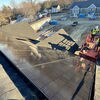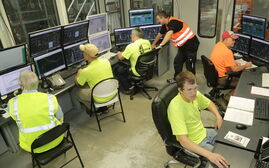Promising scallop aquaculture initiative gets $600K boost
 Courtesy / Coastal Enterprises Inc.
A Maine research team is investigating potential economic benefits of a scallop production technique called “ear-hanging,” in which scallops grow attached to lines hanging vertically in the ocean, as shown above.
Courtesy / Coastal Enterprises Inc.
A Maine research team is investigating potential economic benefits of a scallop production technique called “ear-hanging,” in which scallops grow attached to lines hanging vertically in the ocean, as shown above.
The Foundation for Food and Agricultural Research awarded a $300,000 grant to CEI to investigate the economic viability of a Japanese scallop production technique that has been shown to grow scallops faster as well as produce larger yields of meat.
U.S. Rep. Chellie Pingree, D-1st District, announced Monday that FFAR, a nonprofit corporation established by the 2014 Farm Bill, awarded the $300,000 research grant to Hugh Cowperthwaite of CEI, which is matching the award to double its impact.
It is one four grants totaling $1.5 million announced by FFAR that will fund research to improve economic opportunities for farmed fish, shellfish and marine invertebrate production and increase the supply of domestically-produced, nutritious foods in the United States.
The grants are matched by five companies, one industry association and three universities for a total of $3 million in funding for research including best practices for aquaculture producers and economic feasibility studies. All research results will be shared publicly with the goal of stimulating aquaculture markets.
“Congratulations to Hugh Cowperthwaite of CEI who is researching the farming of Atlantic sea scallops in groundbreaking new ways,” Pingree said in a news release. “The additional funding from FFAR will help CEI continue this pioneering work and produce important research for fisheries across the nation to put to use.”
In a separate news release, CEI reported that sea scallops are among the most lucrative commercial marine species caught in the U.S., with its value often ranking within the top five of all species landed nationally.
Strong potential seen for scallop aquaculture
In 2017, according to Maine Department of Marine Resources, Maine scallop harvesters landed the most scallops since 1997, bringing ashore 793,544 meat pounds, a nearly 45% jump from 2016. At $9.3 million, scallop landings had the highest overall value since 1993.
“Given the high commercial value of sea scallops in the global seafood trade and the growing trend of sourcing sustainably harvested seafood products, there is ample opportunity for farm raised scallops,” CEI stated in its news release. “Yet until now the technical knowledge for scallop aquaculture hasn’t been widely available.”
To address that challenge, CEI purchased three custom scallop aquaculture machines from Japan, which has a well-developed scallop farming industry. The Japanese machinery is now installed at Bangs Island Mussel in Portland and Pine Point Oyster in Scarborough.
“Could scallop farming be a sustainable new job-creating industry for Maine? We think so and we’re setting out to prove it,” said Cowperthwaite, director of the Fisheries Project at CEI who led a Maine aquaculture visit to Japan two years ago along with Dana Morse. “We are utilizing the ‘Japanese ear-hanging technique,’ with a lens on the economics and profitability. We are tracking equipment costs, shipping and maintenance of the machinery, labor costs, scallop growth rates and selling scallops throughout the value chain.”













Comments